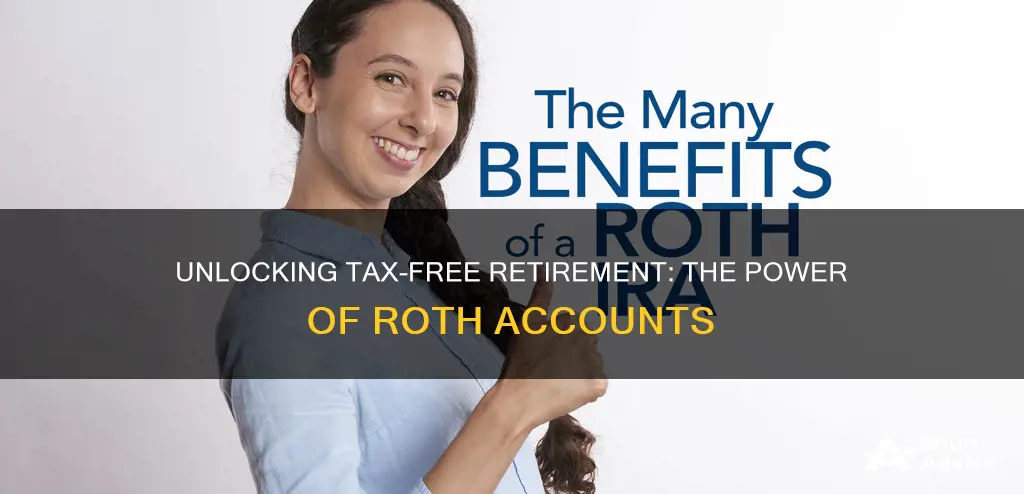
A Roth IRA is a type of tax-advantaged individual retirement account. While there are no immediate tax benefits, your contributions and earnings can grow tax-free, and you can withdraw them tax-free and penalty-free after age 59½. There are no minimum distribution requirements with a Roth IRA, so you can leave your assets in the account where they have the potential to continue growing.
| Characteristics | Values |
|---|---|
| Tax on contributions | Yes |
| Tax on withdrawals | No |
| Tax on investment growth | No |
| Income limits for contributions | Yes |
| Age limits for contributions | No |
| Minimum distribution requirements | No |
| Tax on inherited accounts | No |
What You'll Learn

No upfront tax benefits, but tax-free withdrawals in retirement
A Roth IRA is a type of individual retirement account (IRA) that offers no upfront tax benefits but does allow for tax-free withdrawals in retirement. This means that you pay taxes on the money going into the account, but not on any withdrawals made after retirement. This can be advantageous if you expect to be in a higher tax bracket once you retire, as you will avoid paying higher taxes on your retirement income. Additionally, there are no required minimum distributions during your lifetime, so you can leave the money in the account to continue growing tax-free.
With a Roth IRA, you contribute money that has already been taxed, and any investment gains or earnings on those contributions can also grow tax-free. You can withdraw your original contributions at any time without penalties or taxes, as you have already paid taxes on this money. However, to withdraw earnings tax-free, you must be at least 59 and a half years old, and the account must have been open for at least five years. There are some exceptions to this rule, such as using the money for a first-time home purchase, qualified education expenses, or disability-related expenses.
The main difference between a Roth IRA and a traditional IRA is their tax treatment. While a Roth IRA offers no upfront tax benefits, a traditional IRA allows you to make pre-tax contributions, reducing your taxable income for the year. However, when you withdraw money from a traditional IRA in retirement, it is taxed as income. Traditional IRAs also have required minimum distributions, meaning you must start taking withdrawals at a certain age, while Roth IRAs do not.
When deciding whether to contribute to a Roth IRA or a traditional IRA, consider your current tax bracket and your expected tax bracket in retirement. If you anticipate being in a higher tax bracket in retirement, a Roth IRA may be more advantageous. Additionally, if you want the flexibility to access your contributions without penalties, a Roth IRA may be a better option. On the other hand, if you expect your tax rate to be lower in retirement, a traditional IRA may provide greater benefits.
It is important to note that there are income limits for contributing to a Roth IRA. These limits are adjusted periodically by the Internal Revenue Service (IRS) and depend on your filing status and modified adjusted gross income (MAGI). If your income exceeds the limit, you may not be eligible to contribute to a Roth IRA.
Diamonds: A Risky Investment Gamble
You may want to see also

No age limit for contributions
One of the most appealing aspects of investing in a Roth IRA is that there is no age limit for contributions. This means that, regardless of your age, as long as you are still earning an income, you can continue to make contributions to your retirement fund. This is in contrast to the traditional IRA, where contributions are not permitted after the age of 70.5.
The ability to contribute to your Roth IRA indefinitely provides a significant advantage when it comes to retirement planning. It allows individuals who are nearing retirement or are already retired to continue building their tax-advantaged savings. This is especially beneficial for those who are still working past the retirement age and want to ensure they have sufficient funds for their later years.
Additionally, with a Roth IRA, there are no required minimum distributions (RMDs) that you need to worry about during your lifetime. This means that you can let your investments continue to grow without the requirement to start withdrawing funds at a certain age. However, it's important to note that Roth IRA beneficiaries may need to take RMDs to avoid penalties.
The absence of age restrictions on contributions also provides flexibility for younger individuals. Even minors can have a Roth IRA set up for them as long as they have qualified earned income. This allows young people to get an early start on saving for their future and take advantage of the power of compound interest over time.
While there is no age limit for contributions, it's important to note that eligibility for Roth IRAs does depend on other factors, such as income and tax filing status. There are also contribution limits to consider, which may vary depending on your age and the type of IRA you choose. Nonetheless, the lack of age restrictions on contributions makes Roth IRAs an attractive option for individuals of all ages who are looking to secure their financial future.
Gov't Spending: Young vs. Old
You may want to see also

No mandatory withdrawals
One of the key advantages of investing in a Roth IRA is the absence of mandatory withdrawals, which offers investors greater flexibility and control over their retirement savings. This feature sets Roth IRAs apart from traditional retirement accounts, where individuals are typically required to start making withdrawals at a certain age, usually 72 or older, known as the required minimum distributions (RMDs).
With a Roth IRA, you are not bound by any mandatory withdrawal requirements, meaning you can choose to leave your investments untouched for as long as you wish. This allows your savings to continue growing tax-free, maximising the power of compound interest over time. It also provides the flexibility to adjust your retirement income strategy as needed, without being forced to withdraw funds when you may not need them.
The lack of mandatory withdrawals gives Roth IRA investors the freedom to pass on their retirement savings to future generations. Unlike traditional retirement accounts, where beneficiaries are often required to make immediate withdrawals upon inheritance, Roth IRAs can be passed on to heirs who can continue to benefit from tax-free growth. This feature makes Roth IRAs an attractive option for those who want to leave a financial legacy for their loved ones.
It's important to note that while there are no mandatory withdrawals for Roth IRAs during your lifetime, there may be tax implications if you choose to withdraw earnings within the first five years of opening the account, unless it's for certain specific scenarios like a first-time home purchase or college expenses. However, once you've had the account for five years or more, you can withdraw your earnings without any additional taxes or penalties, enjoying the full benefits of tax-free retirement income.
Southwest Airlines: Invest or Avoid?
You may want to see also

No income tax for inherited accounts
If you inherit a Roth IRA, you can make tax-free withdrawals from the account over 10 years. This is true for most beneficiaries, except for spouses, who can treat the account as their own and make withdrawals without any deadlines.
The original owner of a Roth IRA does not have to take RMDs during their lifetime, so they can leave the entire account to their heirs if they don't need the money. The beneficiary can be designated on the Roth IRA contract, and the money will go directly to them, bypassing probate.
If the original owner of the Roth IRA died before 2020, different rules apply. In this case, the beneficiary has to take RMDs when they inherit a Roth IRA from someone who wasn't their spouse. They can stretch distributions over their lifetime using an IRS uniform life expectancy table to estimate their remaining lifespan based on their age.
If the original owner of the Roth IRA died in 2020 or later, the beneficiary doesn't have to take RMDs, but they need to withdraw the entire amount of the IRA within 10 years.
If the Roth IRA has been open for at least five years, withdrawals of earnings are tax-free. Earnings withdrawn from Roth IRAs that are less than five years old are subject to income tax at the beneficiary's ordinary tax rate, plus a penalty.
Renewable Energy's Return: Does Green Energy Pay Dividends?
You may want to see also

Flexible access to your money
One of the most significant advantages of investing in a Roth IRA is the flexibility it offers in terms of accessing your money. Unlike traditional retirement accounts, Roth IRAs allow you to withdraw your contributions at any time, for any reason, without incurring taxes or penalties. This feature makes Roth IRAs an attractive option for those who want to maintain liquidity while also saving for retirement.
The flexibility of Roth IRAs is particularly notable when compared to other retirement accounts, such as traditional IRAs and 401(k)s, which often impose restrictions and penalties on early withdrawals. With a Roth IRA, you can access your contributions penalty-free and tax-free, regardless of your age or how long you have held the account. This feature provides peace of mind, knowing that your money is easily accessible in case of unexpected expenses or financial emergencies.
Additionally, Roth IRAs offer tax advantages that further enhance their flexibility. Since contributions are made with after-tax dollars, you don't have to worry about paying taxes on withdrawals during retirement. This feature distinguishes Roth IRAs from traditional retirement accounts, where contributions may be tax-deductible upfront, but withdrawals are taxed later. With a Roth IRA, you know exactly how much you have saved and can make withdrawal decisions without worrying about unexpected tax burdens.
It is important to note that while you can withdraw contributions at any time, there are some restrictions on withdrawing earnings from your Roth IRA. Generally, to avoid taxes and penalties on earnings withdrawals, you must be at least 59½ years old and have held the account for at least five years. However, there are special exceptions, such as using the money for a first-time home purchase, college expenses, or other qualified situations.
In summary, the flexibility of a Roth IRA is a significant benefit, allowing easy access to your contributions without taxes or penalties. This feature, along with its tax advantages, makes Roth IRAs a popular choice for those seeking a combination of liquidity and tax-efficient retirement savings.
Investing in Startups: Where to Begin?
You may want to see also
Frequently asked questions
A Roth IRA is a tax-advantaged individual retirement account that allows you to contribute after-tax dollars. While there is no upfront tax benefit, your contributions and investment earnings can grow tax-free, and you can make tax-free and penalty-free withdrawals during retirement. Additionally, there are no age restrictions on contributions, no mandatory withdrawals, and your heirs can inherit the account without incurring income taxes.
The main difference between a Roth IRA and a traditional IRA is their tax treatment. With a Roth IRA, there is no upfront tax deduction, but withdrawals in retirement are tax-free. In contrast, a traditional IRA offers an upfront tax deduction on contributions, and you pay taxes on withdrawals. Another difference is that Roth IRAs do not require minimum distributions during the account holder's lifetime, while traditional IRAs have required minimum distributions starting at age 73.
The income limits for contributing to a Roth IRA vary based on your filing status and are adjusted periodically by the IRS. For 2024, if you are a single filer, your maximum contribution starts to reduce at a Modified Adjusted Gross Income (MAGI) of $146,000, and you are ineligible to contribute if your MAGI exceeds $161,000. For married couples filing jointly, the reduction starts at a MAGI of $230,000, and the contribution limit is reached at a MAGI of $240,000.







